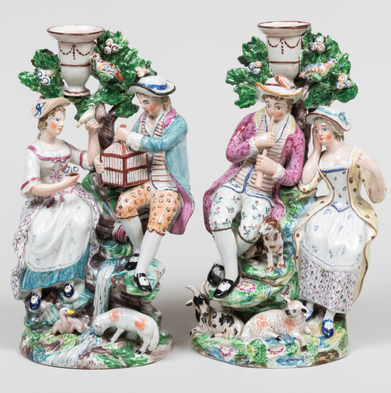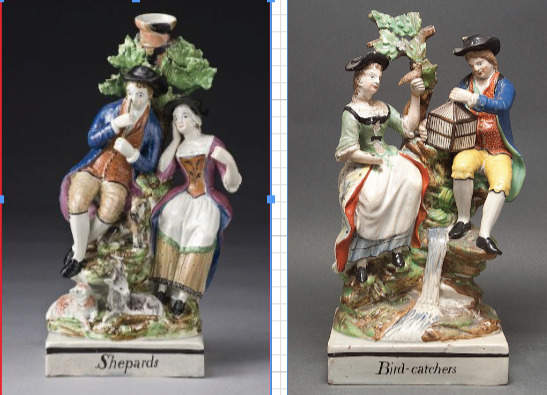|
I am working my way through the makers of Staffordshire pottery figures of the pre-1840 period, and my photo index of John Walton's work is complete. The figures are gorgeous, so I hope you enjoy leafing through it. A free download is available on the Books tab at the top of this page. As always, comments and corrections are welcome.
2 Comments
I am a sucker for the carefully rendered, creamy enamel colors found on early Staffordshire figures of the 1780-1800 period. The Neale factory takes the prize for excellence, but the potter Ralph Wood (active 1782-1795) is a close runner-up, and I enjoy our family’s small collection of his enamel-painted figures. I especially like the group below. Today it is interpreted as being allegorical of married life, and collectors know it as Liberty and Matrimony--the cage symbolizes the restraints of marriage, and the bird represents freedom. But, as we shall see shortly, in his day Ralph Wood simply called this group Bird Catchers. Our group is a little unusual in that the body is a porcelain-pottery hybrid. Wood, who was the founding father of the English pottery industry, experimented with a variety of bodies. Although he favoured pottery, it is not unusual to find one of his models made in some other ceramic material. Wood modeled his own figures, and he sometimes looked to other sources for inspiration. In this case, English porcelain figures are thought to have set the cogs in his brain spinning. The Derby porcelain pair alongside was made circa 1780, and Bow made figures in the same style some decades earlier. They are known as Liberty and Matrimony, the very title that came to be applied to Wood's Bird Catchers in the twentieth century. Wood would have been familiar with these models, but pottery figures lack the pretentiousness of porcelain ones, and Wood intended his group to be nothing more than common-or-garden bird catchers. The titled example below, decorated in a style Wood used later in his career, makes that clear. By the way, bird catching was something of a pastime in those days, and enterprising individuals earned their livings catching birds to adorn the aviaries of the wealthy.  Courtesy Andrew Dando. Courtesy Andrew Dando. For a period in his brief career, Wood impressed model numbers into his figures, and the number 89 is impressed on the reverse of the Bird Catchers in our collection. The men who worked in Wood’s pot bank were relatively illiterate and, at times, less than sober. In any event, they don’t seem to have set much score by those numbers, and errors abounded. For that reason, Bird Catchers can be found impressed either 89 or 90. The vast majority of Staffordshire figure models have companion models, so what did Wood pair with his Bird Catchers? He must have loved shepherds and shepherdesses because he made several pairs, and apparently he thought that a bucolic shepherd and shepherdess fitted the bill. Below is a pair of pottery models that are undeniably Wood’s work. Their bocages (remarkably intact) are typical, and the rainbow-like colors on the bases only occur on figures associated with Wood. It is possible to find these two figure groups numbered 89 and 90, or 90 and 89. It is also possible to find them with candleholders added. The pair I show above is in remarkably fine condition, and, despite a slight difference in the shade of green on the bocages, they appear to be a true pair the has lived side by side always, Wood also made this pair of models decorated in colored glazes, as you see below. Each to his own, and some may prefer this mode of decoration, but for me those pretty enamel colors win any day. Wood also made this pair of models "in the white"--in other words coated with clear glaze only. The examples below have lost much or all of their bocages. And he made them decorated in colored glazes.  Courtesy John Howard Courtesy John Howard Each to his own, but for me those pretty enamel colors win any day. As I type this post, I am, as always, aware that my vast photo archive makes it seem that such figure groups can be found with ease. Far from it. But don't let that stop you looking, and don't hesitate to buy a beautiful single--in my opinion, that's far better than a poor pair. Many examples have lost their bocages over the years yet still retain their beauty, but avoid anything with an extensively restored bocage. Also, remember that nasty reproductions of the shepherds group can be found easily. Made in Asia in recent years, they are crude, garish object, and some even have "WOOD" scratched beneath. The deliberate dirty crazing betrays them for what they are. Yet another few words of advice: if you see other early figure groups of this form, do not assume Ralph Wood made them. After Wood's death, his molds passed to others. In particular, the Dudson factory made figure groups from these molds in the early 1800s. They are charming, but Ralph Wood's are the best. If you want to know more about Ralph Wood’s work, please refer to my PDF on that subject, accessed by clicking here. |
Archives
February 2024
All material on this website is protected by copyright law. You may link to this site from your site, but please contact Myrna if you wish to reproduce any of this material elsewhere. |





















